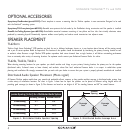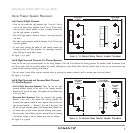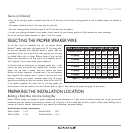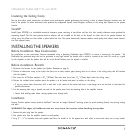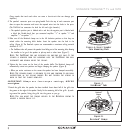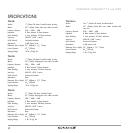
9
SONANCE THINLINE™ TL and SSTR
PAINTING THE SPEAKERS AND GRILLES
You can paint the speakers and grilles before installing them, which will eliminate the “paint scar” that can be left on the ceiling if the speaker ever needs
to be removed for service. You can also paint the speakers after installation, but before the grilles are attached. All Sonance ThinLine speakers come from
the factory fitted with a plastic ‘paint plug’ that protects the speaker drivers while the mounting flange is being painted.
Sonance always suggests painting the grille separately from the speaker. Before painting, carefully remove the under-grille cloth. It is held in place with a
light tacking glue that makes it easy to remove.
Spray the grilles with thinned paint (5 parts thinner to 1 part paint), being careful not to plug the holes. Too heavy a coat of paint on the grille will
adversely affect the sound of the speaker.
Once the grilles and flange are painted and dry, replace the under-grille cloth, remove the paint plug from the mounting flange and install the grille.
SPEAKER ADJUSTMENTS
Pivoting Tweeter
ThinLine TL623
R and TL622R have a pivoting tweeter. This lets you direct sound toward or away from the listening area,
depending on how the speakers are being used:
• If you’re using the speakers in stereo or as the front left/center/right speakers in a home theater, pivot the tweeter
directly towards the listening area. This will help the sound from the speakers blend into a solid soundstage even if
the speakers are widely separated.
• If you’re using the speakers as surround channel speakers in a home theater, you can create a more diffuse, spacious
surround effect by pivoting the tweeters towards a wall or window, away from the listeners.
To Pivot the Tweeter:
Apply light pressure to the plastic ring around the outside edge of the tweeter dome, as shown in
Figure 9
. Do not
touch or apply pressure to the tweeter dome.
Tweeter Level Control
The ThinLine TL623R and TL623SSTR have a tweeter level control switch (see
Figure 10
) that lets you boost or cut the tweet-
er’s level by 3dB. This allows you to adjust the speaker’s brightness to better match your listening room or personal taste.
Once you have installed the speakers, listen to a variety of music that you are familiar with. If the music all tends to
sound too bright or dull, use the Tweeter Level Control to compensate. If some recordings sound dull and some sound bright
the speaker is accurately reproducing differences in the recordings, and you should leave the control in the middle (0dB)
position.
Figure 9:
Pivoting the Tweeter
Tweeter
Level Control
Figure 10:
Tweeter Level
Control






